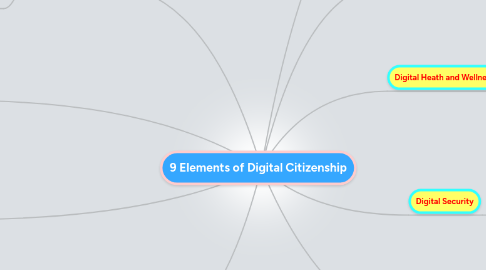9 Elements of Digital Citizenship
Monique Hにより

1. Digital ediquette
1.1. The standard conduct expected by other digital technology.
1.2. tolking on the phone in the privetcy of your own home.
1.3. Texting and driving.
2. Digital Acsess
2.1. Full electronic participation in society.
2.2. Using social networks to talk to old friends.
2.3. Using social networks to bully others.
3. Digital Commerce
3.1. The buying and selling of goods online.
3.2. Shopping online to get a good sale.
3.3. buying things online to resale them.
4. Digital Communication
4.1. The electronic exchange of information.
4.2. Using a cellphone to send a friend the notes from school.
4.3. Using a cellphone to cheat on a test.
5. Digital Rights and Responsibilities
5.1. Thge privileges and freedoms extended to all digital technology users, and the behavioral expectations that come with them.
5.2. Students cite web sites or other digital media sources when using information for class projects.
5.3. Students do not properly cit sources fom the internet Students violate AUP because they view it as unfair.
6. Digital Heath and Wellness
6.1. Teh elements of physical and psychological well being related to digital technology use.
6.2. Students learn about health and wellness as it telates to technology.
6.3. Possible harmful physical effects of technology are ignored Proper erganomics are not followed when using technology.
7. Digital Security
7.1. Students are awre of the dangers of providing infor matino to anyone overthe internet Make sure virus pro tection and firewalls are properly updated and configured to protect personal information.
7.2. The precautions that all technology users must take to guaranee their personal sfety and the security of their network.
7.3. Students fail to protet their identity Users fail to maintain current software updates or patches that protect their computers from viruses and exploitation.
8. Digital Law
8.1. The legal rights and restrictions governing technology use.
8.2. Students understand what can be downloaded for free and what is considered copyrighted material and should be paid for Students do not share capyrighted material with others.
8.3. Students download copyrighted music from file sharing sites Students create copies of copyrighted movies for their friends.
9. Digital Literacy
9.1. The capabiltty to use digital technology and knowing when and how to use it
9.2. Students use digital technologies in new ways Students use online materials.
9.3. Students are not provided with resources and materials that they can access away from the classsroom so they will be unable to use and learn about these tools.


